The Ballad of Goo Ballou —
the Sequel to . . .
“Let me count the ways” is an appropriate request
for students of the discrete , as opposed to the
continuous , which instead requires measurement .
Related academic material —
Raymond Cattell on crystallized vs. fluid intelligence.
For a more literary approach, see Crystal and Dragon
and For Trevanian.
This post was inspired in part by
the American Sequel Society and . . .





























